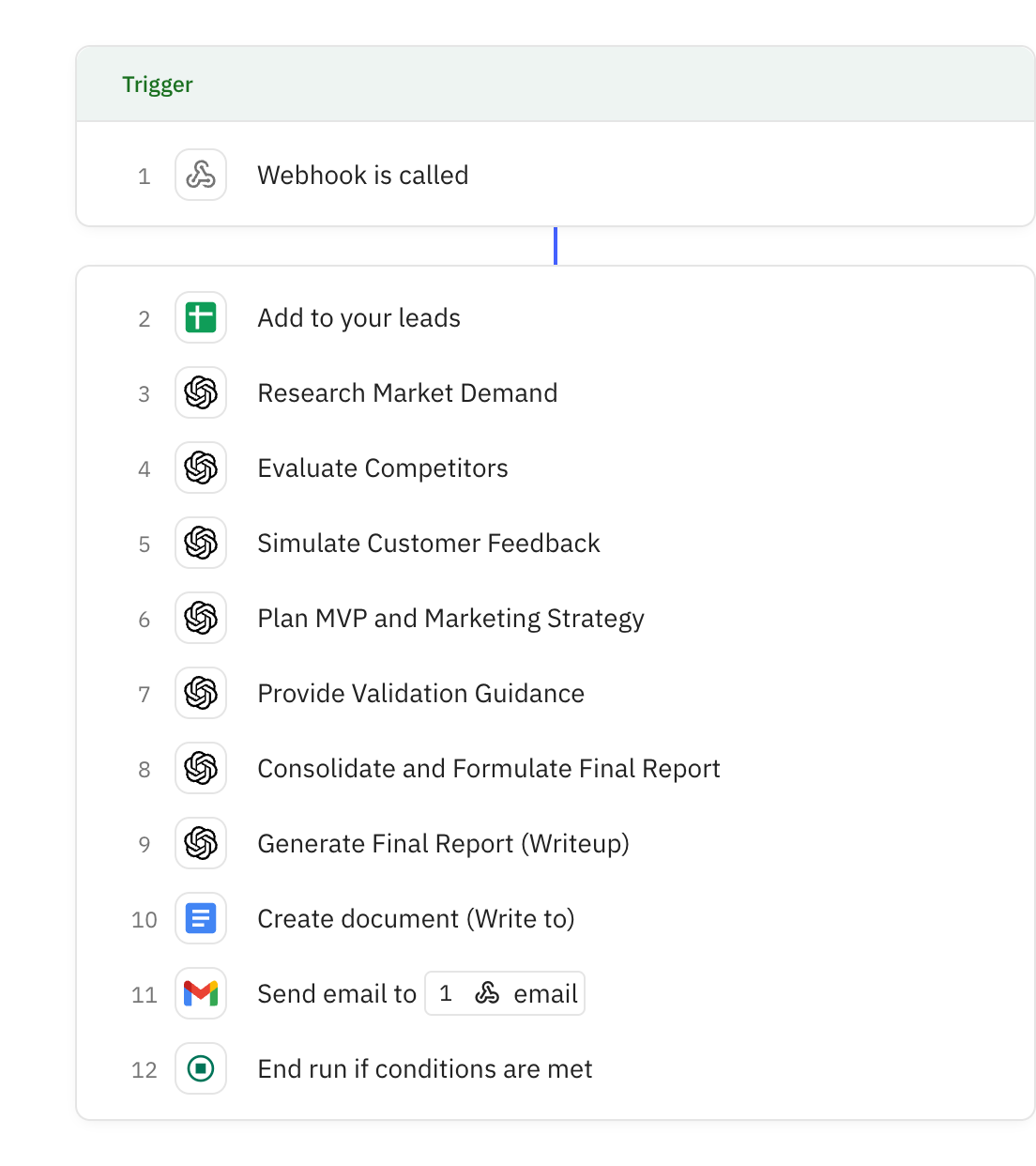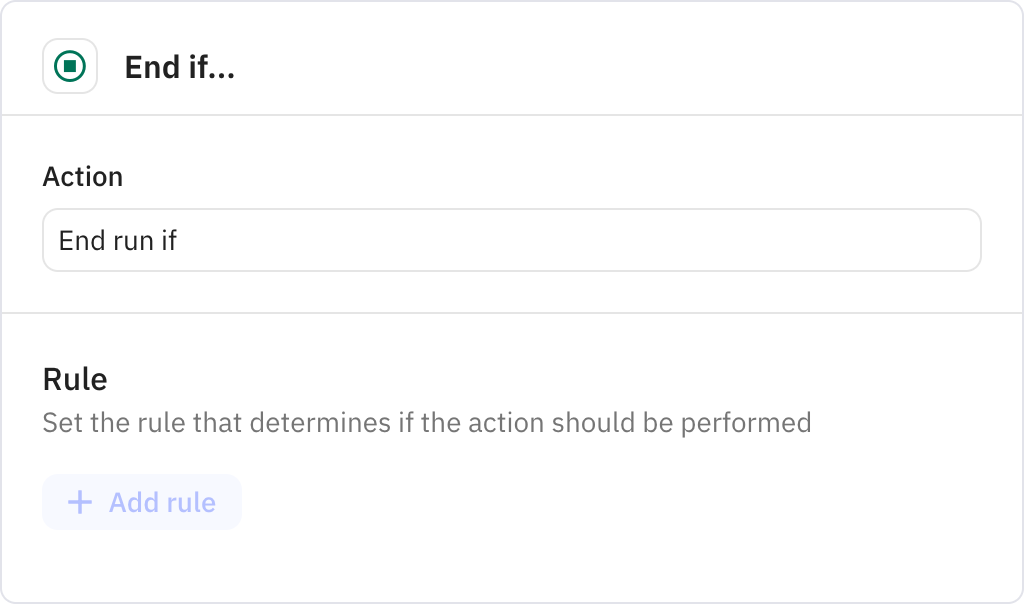Consolidates all analysis results into a comprehensive final report. Calculates an overall startup score (1-10) and provides key insights with actionable next steps based on all previous analyses.
Generate a final validation report for a Micro SaaS idea by aggregating and synthesizing the results from the questionnaire, market research, competitor analysis, simulated user feedback, MVP/go-to-market recommendations, and validation workflow. Calculate an overall startup score (1-10) and provide actionable next steps. Return a JSON object with a structured report.
Input Data:
Questionnaire Responses: [data], [data], [data], [data] and [data]
What specific problem does your Micro SaaS idea aim to solve? [data]
Who is your target audience? [data]
What are the core features of your Micro SaaS product? [data]
How do you plan to monetize your Micro SaaS? [data]
Are you aware of any competitors or existing solutions addressing this problem? [data]
Questionnaire Responses: {{questionnaire.responses}}
Market Research Report: [data]
Competitor Analysis Report: [data]
Simulated User Feedback Report: [data]
MVP and Go-to-Market Report: [data]
Validation Workflow Report: [data]
Extracted Keywords: {{keywords}}
Instructions:
Summary of Findings: Summarize key findings from each step:
Idea Input: Highlight the problem ([data]), target audience ([data]), features ([data]), pricing ([data]), and competitors ([data]).
Market Research: Summarize demand score, search trends, and social insights.
Competitor Analysis: Summarize competitor score, key competitors, and differentiation opportunities.
User Feedback: Summarize sentiment score, persona reactions, and insights.
MVP and GTM: Summarize recommended MVP features, tools, and marketing tactics.
Validation Workflow: Summarize validation steps, expected metrics, and simulated outcomes.
Startup Score: Calculate an overall startup score (1-10) based on:
Market demand score (from market_report, 25% weight). [data]
Competitor score (from competitor_report, 25% weight). [data]
Sentiment score (from feedback_report, 25% weight). [data]
Validation potential (from validation_report’s simulated outcomes, 25% weight). [data]
Adjust weights if any step indicates critical risks or opportunities (e.g., very low demand score).
Key Insights: Provide 3-5 key insights combining data from all steps (e.g., strong demand but high competition, pricing concerns from feedback).
Next Steps: Recommend 3-5 actionable next steps based on the aggregated findings (e.g., build MVP, adjust pricing, scale marketing, pivot idea).
Output Format: Return a JSON object with:
summary (object with sections for idea, market, competitors, feedback, mvp_gtm, validation)
startup_score (float, 1-10)
key_insights (array of 3-5 insights)
next_steps (array of 3-5 actionable recommendations)
conclusion (brief statement on the idea’s overall potential)
Example Output: { "summary": { "idea": { "problem": "Small businesses struggle with email subject lines for cold outreach.", "audience": "Freelancers, small businesses, marketing teams.", "features": "AI subject lines, Mailchimp/HubSpot integration, analytics.", "pricing": "$9/month basic, $29/month pro, 14-day trial.", "competitors": "Mailchimp, SubjectLine.com." }, "market": { "demand_score": 8, "trends": "High search volume for email subject lines, 20% growth.", "social_insights": "Positive sentiment in r/SaaS for AI tools." }, "competitors": { "competitor_score": 7, "key_competitors": "Mailchimp (no AI personalization), SubjectLine.com (limited features).", "differentiation": "AI personalization, niche integrations." }, "feedback": { "sentiment_score": 7.5, "reactions": "Freelancers love $9/month, businesses want ROI proof.", "insights": "Add A/B testing for marketing teams." }, "mvp_gtm": { "mvp_features": "AI subject lines, Mailchimp integration, basic analytics.", "tools": "Bubble, Zapier.", "gtm": "LinkedIn ads ($50), Reddit posts." }, "validation": { "steps": "Carrd landing page, LinkedIn ads, r/SaaS posts.", "metrics": "Expect 40 sign-ups, 1.8% CTR, 15 comments.", "outcomes": "Strong simulated interest." } }, "startup_score": 8.0, "key_insights": [ "High market demand for AI email tools.", "Moderate competition with clear differentiation opportunities.", "Freelancers are highly receptive, but businesses need ROI evidence.", "Validation steps show strong potential for sign-ups." ], "next_steps": [ "Build MVP with Bubble, focusing on AI subject lines and Mailchimp integration.", "Launch Carrd landing page with fake door test to collect sign-ups.", "Run $50 LinkedIn ad campaign targeting freelancers.", "Engage in r/SaaS to gather qualitative feedback.", "Add ROI metrics to address small business concerns." ], "conclusion": "The idea shows strong potential with high demand and clear differentiation. Proceed with MVP development and validation." }














